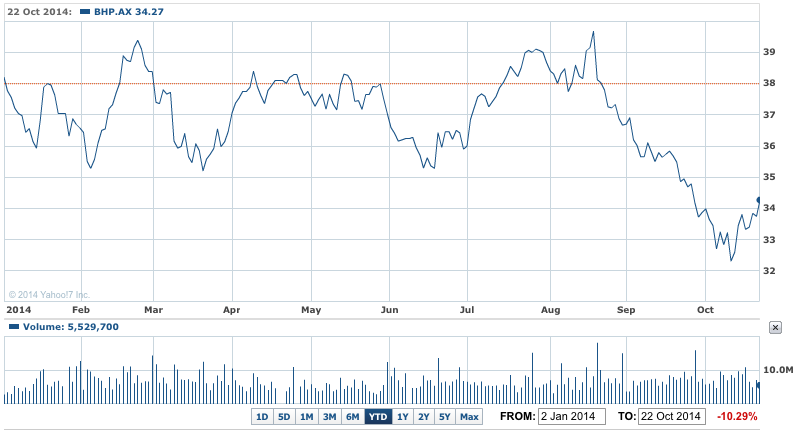Like its great rival Rio Tinto (RIO) last week, BHP Billiton (BHP) yesterday produced a September production and sales report that surprised on the upside – especially in iron ore, petroleum and the biggest surprise of all – a surge in coking coal from its mines in Queensland.
CEO Andrew Mckenzie said in yesterday’s statement, “Robust operating performance across our diversified portfolio in the September 2014 quarter delivered a nine per cent increase in production with records achieved across eight operations and four commodities. Group production growth of 16 per cent is expected over the two years to the end of the 2015 financial year.”
BHP said it produced 62 million tonnes of iron ore from its West Australian mines (around 23% less than Rio Tinto), making it ahead of schedule on its promise to produce 245 million tonnes in the 2015 financial year.
BHP believes its expansion strategy can make it the lowest cost producer of iron ore in the world, (its average mine produced price was $US25.89 a tonne in the year to June, while Rio Tinto’s average cost in the June quarter was just over $US20 a tonne) and earlier this month revealed plans to cut this to as close to $US20 a tonne over the next couple of years.
The big shock from the report was the 25% rise in coking coal production. The 13 million tonnes produced beat all forecasts and came despite continuing weakness in global prices for the key steel making ingredient.
BHP said its Queensland Coal division "achieved record production and sales volumes. The new Caval Ridge mine operated at capacity during the period while the Daunia and South Walker Creek mines also produced at a record rate. Total metallurgical coal production is forecast to increase by four per cent in the 2015 financial year to 47 Mt, consistent with prior guidance.”
BHP YTD – Record iron ore, coking coal production at BHP

BHP also reported a 49% surge in production of oil and gas liquids from its US shale operations in the quarter.
Output of oil, condensates and gas liquids in the onshore US jumped to a record 11.5 million barrels of oil equivalent (boe) in the September quarter, helping lift the mining major’s total oil and gas production for the three months by 7% from the September 2013 quarter to 67.4 million boe.
Despite this big improvement, BHP left its guidance for petroleum production in the 2014-15 financial year unchanged at 255 million barrels of oil equivalent, a 5% increase on the previous year, which is all down to the shale business. Production of conventional oil and gas is forecast to be roughly flat.
The jump in onshore liquids production in the US in the September quarter was driven by BHP’s key Black Hawk shale venture in the Eagle Ford region of southern Texas, and by the rapidly growing business in the Permian region in the state’s west. In the Black Hawk, liquids production jumped by 53%, while it more than doubled in the Permian, where BHP is at an earlier stage of development.
Both areas are, with the Bakken fields in Noerth Dakota, the hot spots for US onshore oil and gas production from so-called tight rock formations.
BHP said Escondida copper production fell 3% in the September quarter to 269,000 tonnes "as strong operating performance was offset by a 12 per cent decline in ore grades, industrial activity and a power outage throughout Northern Chile".
"The temporary reduction in ore grades was anticipated, ensuring production guidance for Escondida remains unchanged at 1.27 Mt of copper for the 2015 financial year. Total copper production is forecast to increase by five per cent to 1.8 Mt, consistent with prior guidance.
"A US$361 million increase in the budget of Escondida Organic Growth Project 1 to US$4.2 billion was approved during the period. The project remains on schedule for completion in the first half of the 2015 calendar year," BHP said.
And energy (thermal) coal production fell 9% in the quarter to 18 million tonnes "as adverse weather constrained production at both Cerrejón and New South Wales Energy Coal. Total energy coal production of 73 Mt is expected for the 2015 financial year, consistent with prior guidance,” the company said.
Mr Mackenzie added:
“Our relentless focus on productivity continues to yield strong results. At Western Australia Iron Ore, we have completed our major supply chain investments and, for the first time in a decade, we have no major projects in execution. With our focus now on maximising the value of existing infrastructure, we plan to reduce costs and invest judiciously in very low capital cost debottlenecking initiatives.”
"These plans are expected to increase total supply chain capacity to 290 Mtpa by the end of the 2017 financial year and reduce unit costs by at least 25 per cent to less than US$20 per tonne. When combined with other initiatives across our portfolio we are very well positioned to reduce cash costs by more than US$2.3 billion and deliver volume-related productivity gains of at least US$1.2 billion by the end of the 2017 financial year,” he said.
BHP shares edged up 1.5% to $US34.27.













